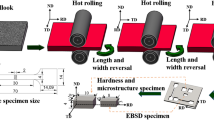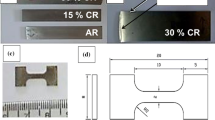Abstract
The thermal processing of rolled rings inevitably generates and accumulates massive residual stresses, as quenching residual stresses produced by water cooling treatment. Non-uniformly distributed residual stresses would seriously affect the structural strength, dimensional stability and service life of the component. In the traditional rolling process of titanium alloy rings, the quenching residual compressive stresses introduced by solution treatment could reach – 400–600 MPa, for which effective control of the stresses is an urgent issue to be solved. In this research, the stress control efficiency of rolling rings under different process routes was explored according to the thermal bulge stress relief technique. The FEM model of the stress evolution in the whole process of the rolled ring was established. The residual stresses on the ring surface are characterized by the hole-drilling method, while the microstructures are characterized by electron backscatter diffraction. The results indicated that the optimized process incorporating the thermal bulging stress relief technique reduced the levels of stress values to within about ± 50 MP and the stress homogenization index by approximately 60–90%.


























Similar content being viewed by others
Data availability
The authors confirm that the data supporting the findings of this study are available within the article.
References
Tao P, Shao H, Ji ZJ, et al. Numerical simulation for the investment casting process of a large-size titanium alloy thin-wall casing. Prog Nat Sci-Mater. 2018;28(4):520–8.
Fan XG, Yang H, Sun ZC, et al. Effect of deformation inhomogeneity on the microstructure and mechanical properties of large-scale rib–web component of titanium alloy under local loading forming. Mater Sci Eng, A. 2010;527(21–22):5391–9.
Cai JM, Mi GB, Gao F, et al. Research and development of some advanced high-temperature titanium alloys for aero-engine. Cailiao Gongcheng/J Mater Eng. 2016;44(8):1–10.
Tomas J, Hitzler L, Koller M, et al. The dimensional accuracy of thin-walled parts manufactured by laser-powder bed fusion process. J Manuf Mater Proc. 2020;4(3):91.
Warhadpande A, Sadeghi F, Evans RD, et al. Influence of plasticity-induced residual stresses on rolling contact fatigue. Tribol T. 2012;55(4):422–37.
Allison B, Subhash G, Arakere N, et al. Influence of initial residual stress on material properties of bearing steel during rolling contact fatigue. Tribol T. 2014;57(3):533–45.
Lyubenova N, Jacquemin M, Bahre D. Influence of the pre-stressing on the residual stresses induced by deep rolling. Residual Stresses 2016: Icrs-102017;2:253–258
Chen SG, Zhang YD, Wu Q, et al. Residual stress relief for 2219 aluminum alloy weldments: a comparative study on three stress relief methods. Metals-Basel. 2019;9(4):419.
Wu Q, Wu J, Zhang Y, et al. Analysis and homogenization of residual stress in aerospace ring rolling process of 2219 aluminum alloy using thermal stress relief method. Int J Mech Sci. 2019;157–158:111–8.
Song H, Gao HJ, Wu Q, et al. Residual stress relief mechanisms of 2219 Al-Cu alloy by thermal stress relief method. Rev Adv Mater Sci. 2022;61(1):102–16.
Junjie X, Dongsheng L, Xiaoqiang L. Modeling and simulation for the stress relaxation behavior of Ti-6Al-4V at medium temperature. Rare Metal Mater Eng. 2015;44(5):1046–51.
Wang BX, Yi YP, Huang SQ, et al. Reduction of residual quenching stresses in 2A14 aluminum alloy tapered cylinder forgings via a novel cold bulging process. Metals-basel. 2021;11(5):717.
Li J, Wu Y, Gong H. Effect of bulging on quenching residual stress of 2219 aluminum alloy ring. Heat Treat Met. 2021;46(7):114–20.
Li XX, Tang YH, Zhang Y, et al. Relaxation of the residual stress in an aluminum alloy ring by electromagnetic bulging methods. IEEE T Appl Supercon. 2022;32(6):1–5.
Wei ZJ, Li JS, Yang YH, et al. Effect of bulging process on residual stress and its distribution of TC4 alloy ring forgings. Rare Metal Mat Eng. 2019;48(8):2537–43.
Lv N, Liu D, Yang YH, et al. Multi-response optimization of the bulging-processed parameters for enhanced residual stress state of TC4-rolled rings. Int J Adv Manuf Tech. 2022;122(7–8):3075–93.
Rolph J, Preuss M, Iqbal N, et al. Residual stress evolution during the manufacture of aerospace forgings. Superalloys 2012. 2012:881–891
Rae W, Rahimi S. Evolution of microstructure and residual stress in hot rolled Ti-6A-4V plates subjected to different heat treatment conditions. Residual stresses 2018, Ecrs-102018;6:171–176
Bi Z, Qin H, Dong Z, et al. Residual stress evolution and its mechanism during the manufacture of superalloy disk forgings. Acta Metall Sin -Chin Edition-. 2019;55(9):1160–74.
Luo J, Li M, Li H, et al. High temperature deformation behavior of TC4 titanium alloy and its flows stress model. T Nonferr Metal Soc. 2008;018(008):1395–401.
Luo J, Li M, Li H, et al. Effect of the strain on the deformation behavior of isothermally compressed Ti–6Al–4V alloy. Mater Sci Eng A. 2009;505(1):88–95.
Zhao XL, Lu XH, Wang K, et al. Investigation on the microstructure and mechanical properties of Ti6Al4V titanium alloy electron beam welding joint. P I Mech eng C-J Mech. 2022;236(6):2957–66.
Rihacek J, Sigmund L. Production of rolled profile and its verification by using numerical simulation. MM Sci J. 2018;2018:2451–4.
Pater Z. A comparative analysis of forming railway axles in 3-and 4-roll rolling mills. Materials. 2020;13(14):3084.
Lv N, Liu D, Hu Y, et al. Multi-objective optimization of parametric design for profile ring rolling process based on residual stress control. Int J Adv Manuf Tech. 2022;119(9–10):6613–31.
Beghini M, Bertini L, Giri A, et al. Measuring residual stress in finite thickness plates using the hole-drilling method. J Strain Anal Eng. 2019;54(1):65–75.
Bobzin K, Wietheger W, Knoch MA, et al. Comparison of residual stress measurements conducted by X-ray stress analysis and incremental hole drilling method. J Therm Spray Techn. 2020;29(6):1218–28.
Alegre JM, Diaz A, Cuesta II, et al. Analysis of the influence of the thickness and the hole radius on the calibration coefficients in the hole-drilling method for the determination of non-uniform residual stresses. Exp Mech. 2019;59(1):79–94.
Lv N, Liu D, Yang Y, et al. Studying the residual stress homogenization and relief in aerospace rolling ring of GH4169 alloy using aging treatment. Int J Adv Manuf Technol. 2021;112(19):1–15.
Funding
This study was funded by the Natural Science Foundation of Chongqing, China (No. cstc2020jcyj-msxmX0046) and the National Natural Science Foundation of China (No.52101052).
Author information
Authors and Affiliations
Corresponding authors
Ethics declarations
Conflict of interest
The authors have no relevant financial or non-financial interests to disclose.
Ethical approval
This article does not contain any studies with human participants performed by any of the authors.
Research involving human participants and/or animals
This research did not involve human participants and/or animals.
Additional information
Publisher's Note
Springer Nature remains neutral with regard to jurisdictional claims in published maps and institutional affiliations.
Rights and permissions
Springer Nature or its licensor (e.g. a society or other partner) holds exclusive rights to this article under a publishing agreement with the author(s) or other rightsholder(s); author self-archiving of the accepted manuscript version of this article is solely governed by the terms of such publishing agreement and applicable law.
About this article
Cite this article
Lv, N., Liu, D., Wang, J. et al. Residual stresses evolution and process route optimization of TC4 profiled rolled rings incorporating thermal bulging. Archiv.Civ.Mech.Eng 23, 200 (2023). https://doi.org/10.1007/s43452-023-00737-0
Received:
Revised:
Accepted:
Published:
DOI: https://doi.org/10.1007/s43452-023-00737-0




